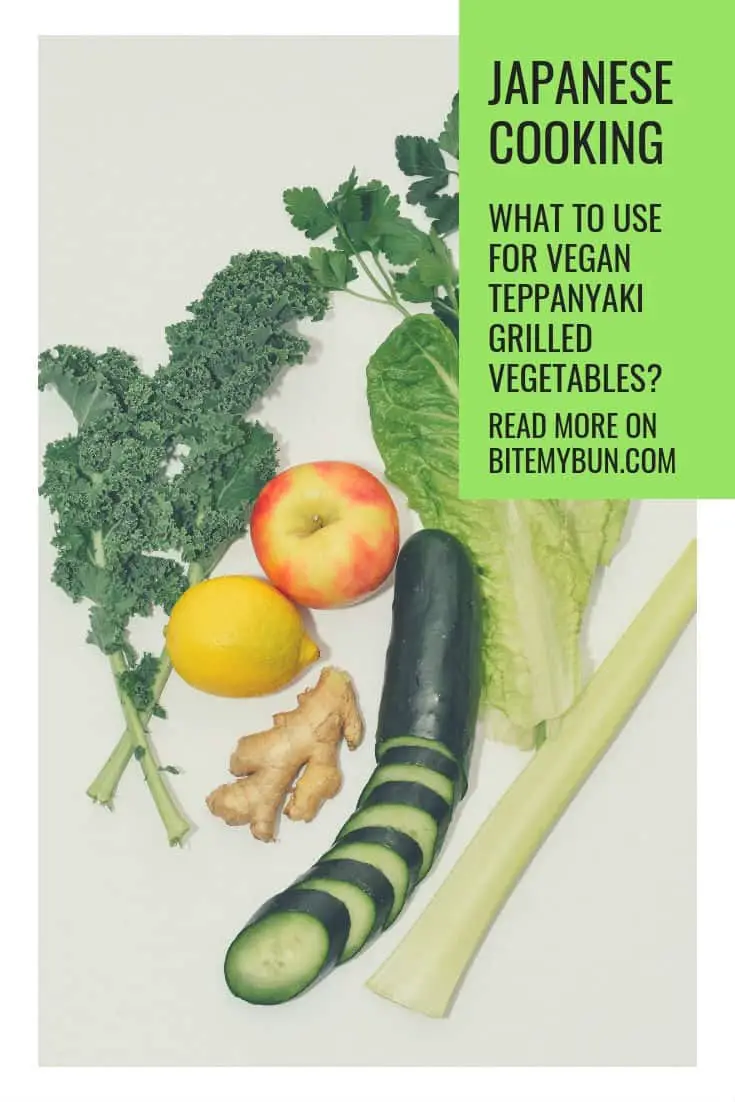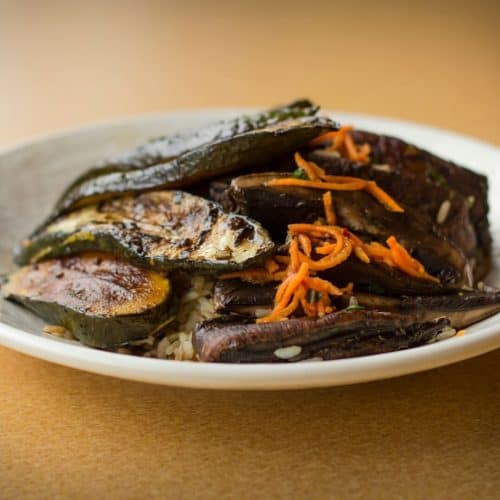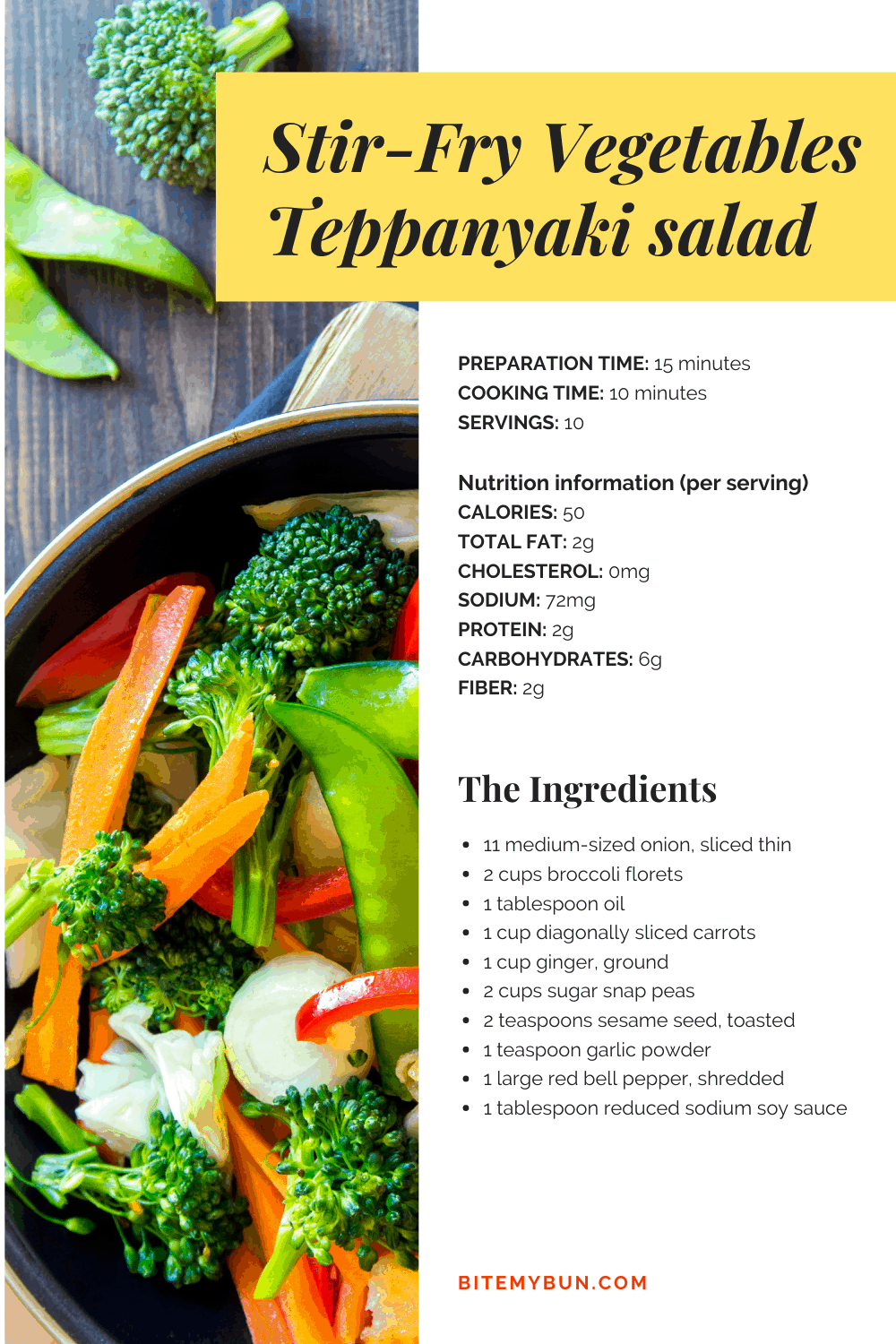2 Vegan Japanese Vegetable Teppanyaki Recipes | cook in 16 minutes
Most people associate the word teppanyaki with Japanese and beef because teppanyaki beef is the most common of the dishes.
However, the little known fact is that any dish that is prepared in a teppan can be referred to as teppanyaki.
This means that if you see anything getting cooked in a teppan when you visit your favorite teppanyaki restaurant, be it chicken, eggs, beef, vegetables, pork , or even seafood, you might as well call it teppanyaki.


Check out our new cookbook
Bitemybun's family recipes with complete meal planner and recipe guide.
Try it out for free with Kindle Unlimited:
Read for freeIn this post we'll cover:
Let’s get you started
Vegetable teppanyaki involves a mixture of a variety of vegetables prepared in a teppan.
These vegetables may be bean sprouts (maybe even raw!), cabbage, mushrooms, beans, courgettes, capsicum, and carrots.
The dish is usually served with freshly steamed rice and meat that is prepared in the same teppan.
The cooking vessel you use in cooking vegetable teppanyaki will play a major role in the outcome.
It is important to use a teppan or something similar because cooking it in something different like a wok will produce different results.
The accumulation of liquid in one area will stew the vegetables rather than grilling them.
I also have some tabletop grills in my buying guide for you to take a look at.

Lightly Fried Japanese Vegetable Teppanyaki
comes in form of preparing the vegetables. It is important that they
are sliced accordingly so as to cook evenly.
Equipment
- Teppan plate
- or: wok
Ingredients
- 1/4 white cabbage julienned
- 1 zucchini thinly sliced
- 2 carrots julienned
- 1 cup spring onions chopped
- 1 small white onion sliced
- 1 small red capsicum (pepper) sliced
- 1 tbsp rice wine vinegar
- 1 tbsp mirin
- 1 tbsp light soy sauce
- salt to taste
- 1 tsp sesame seeds toasted
Instructions
- Heat up a teppan/large griddle to high temperature.
- Add sesame and wait until it is near smoking point before adding the
vegetables. Leave it in the teppan or wok until one side partly
turns brown, then remove them from the plate and set aside. - Create a mixture of the light soy sauce, rice wine vinegar and mirin
then sprinkle it over the vegetables. Stir the vegetables to create
some moisture. Cook the vegetables for up to 2 minutes while making sure
they are still crispy. - Add salt to taste then serve with toasted sesame seeds.
- Serve with cooked or fried rice or as a side dish
Vegetable teppanyaki is a favorable dish, especially on an outdoor barbeque. Use heavy iron skillet or griddle with very high heat for best results when cooking indoors.
This recipe serves up to 4 side helpings and is best served with tofu (or meat if you don’t want to keep it vegetarian) and rice.
Also read: these are those thick Japanese noodles: Udon
Recipe 2: Stir-Fry Vegetables Teppanyaki salad

The stir-fry method of cooking has its origin in Japan, where a meal is made using in a wok (conventional), metal pan, or bowl, and high heat to prepare meat or vegetables.
Stir-fry is common worldwide since preparation time is minimal, end results are splendid and almost anyone can prepare a stir-fry meal.
For the best results, fresh vegetables in season should be used. You may also try with bok choy, zucchini, snow peas or yellow squash.
PREPARATION TIME: 15 minutes
COOKING TIME: 10 minutes
CALORIES: 50
INGREDIENTS: 10
SERVINGS: 10
Ingredients
-
- 1 medium-sized onion, sliced thin
- 2 cups broccoli florets
- 1 tablespoon oil
- 1 cup diagonally sliced carrots>
- 1 cup ginger, ground
- 2 cups sugar snap peas
- 2 tea spoons sesame seed, toasted
- 1 teaspoon garlic powder
- 1 large red bell pepper, shredded
- 1 tablespoon reduced sodium soy sauce
Nutrition information (per serving)
CALORIES: 50
TOTAL FAT: 2g
CHOLESTEROL: 0mg
SODIUM: 72mg
PROTEIN: 2g
CARBOHYDRATES: 6g
FIBER: 2g
Preparation
- Heat up your wok pan for 1 to 2 minutes over a stable top burner on medium heat.
- Add the cut ingredients, carrots and onions first and stir-fry for two minutes. Add remaining vegetables and stir-fry for 5-7 minutes until vegetables are tender-crisp.
- Add any sauces for the stir-fry at the end. You may add any sauce you wish to your dish. It is favorable to add controlled amounts of sauce as too much of it will result in a much dish, and also lower the heat of the wok. Add garlic powder, soy sauce, ginger, and stir-fry until they mix together. Sprinkle with sesame seed.
- Let the stir-fry cook and reduce slightly in the next 3-4 minutes. Stir as required. If you are daring, perform a flick with a rapid hand motion but don’t overdo this. In the next few moments, ensure that the sauce and vegetables are cooked.
- Empty your stir-fry on its own, or use the ideas provided to creatively spice up your meal. Serve over cooked rice, if desires.
Tips for the best stir-fry vegetable Teppanyaki
- Slice vegetables uniformly for even cooking.
- If using a fryer, make the flame hotter. It has better results.
- Peanut and safflower oil are more heat tolerant than other vegetable oils (check more substitutes here)
- To keep the vegetables crisp, don’t cook for too long or add too much sauce.
- If possible, add herbs such as basil and even cilantro.
- It is fascinating how the wok will allow you to keep the ingredients away from the cooking area, and their temperature is kept steady but they don’t overcook. When you are done cooking the meat, shift it to the wok’s edge.
- Add sauces by swirling them into the sides to keep the wok hot.
- Tweak your sauces to the preferred tastes.
- Some sauces contain fortifications such as minced ginger or garlic. If they don’t, consider adding some to the stir-fry.
- Add meat to vegetables evenly and allow enough time for the meat to sear.
- Add dry vegetables to a wok to avoid ending up with a braise. It also prevents sogginess.
- Heat the wok correctly, then quickly remove from heat in a swirl to avoid smoking.

Read more: these are the most popular Japanese foods right now
Check out our new cookbook
Bitemybun's family recipes with complete meal planner and recipe guide.
Try it out for free with Kindle Unlimited:
Read for freeJoost Nusselder, the founder of Bite My Bun is a content marketer, dad and loves trying out new food with Japanese food at the heart of his passion, and together with his team he's been creating in-depth blog articles since 2016 to help loyal readers with recipes and cooking tips.
